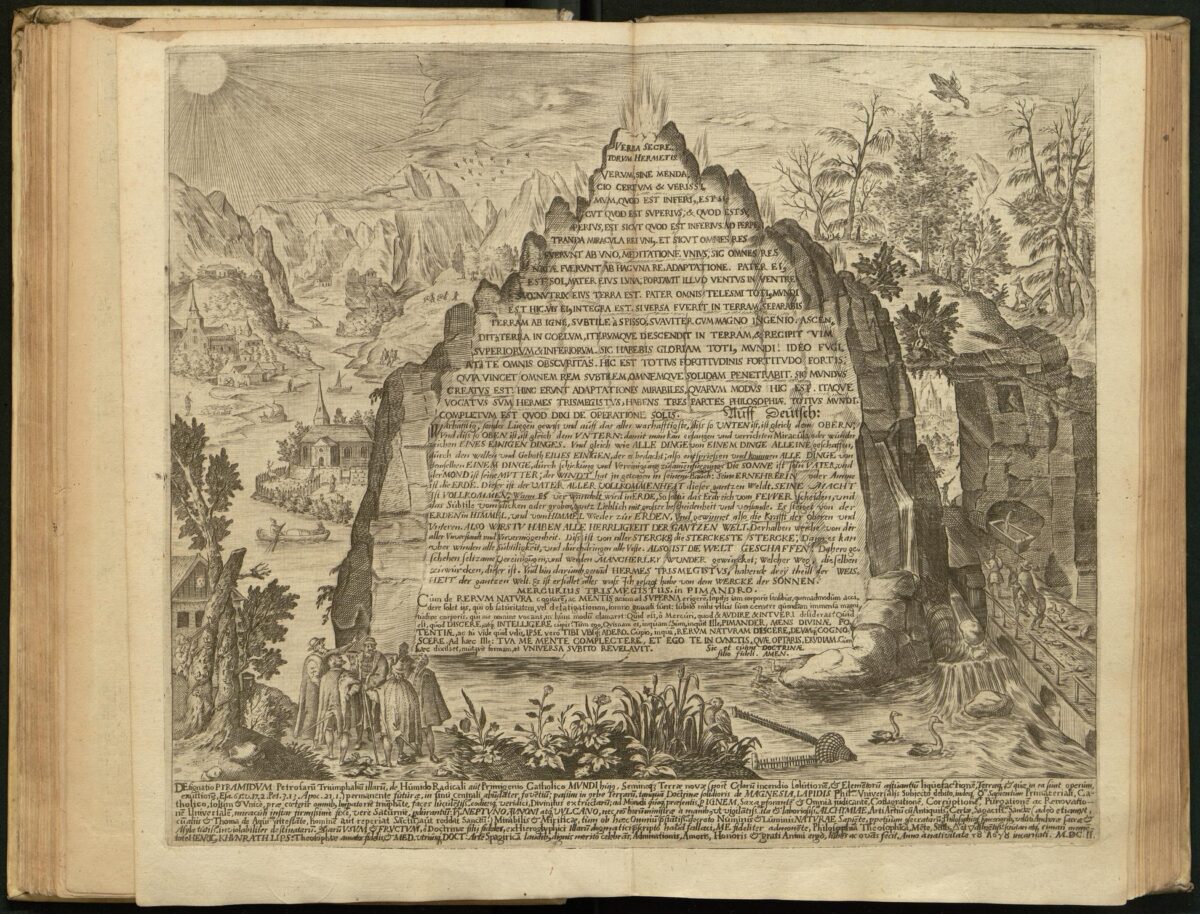Johann Diricks van Campen, Hieroglyphische Figur mit dem Text der Tabula Smaragdina, 1602, in: Heinrich Khunrath, Amphitheatrum Sapientiae Aeternae, Hanau: Wilhelm Anton 1609, ULB Sachsen-Anhalt, Sign. AB 171174>
The original 1595 edition of the German Theosopher Heinrich Khunrath’s (1560-1605) Amphitheatre of Eternal Wisdom contains four circular Theosophical Figures, which are supplemented in the later 1609 edition with five double-page rectangular Hieroglyphic Figures. This rectangular engraving from the enlarged, second edition represents, in Khunrath’s words, „a depiction of those Triumphal Rocky Pyramids“,[1] giving a distinctly Egyptian feel to the image. Khunrath knew that the Greek word ‘Pyramid’ contained the word ‘Pyr’ for ‘Fire’ and if you look closely you will see seven flames rising from the top of this vaguely triangular mountain. The flames most likely symbolise the correspondences believed to exist between the seven planets of the Ptolemaic cosmos and the seven alchemical metals (Sun = Gold; Moon = Silver, etc).
The choice to mention a Pyramid must have been made for a couple of reasons, one being the association of volcanos and the Roman god Vulcan with the ‘art of fire’, alchemy; the other being alchemy’s association with the legendary Egyptian inventor of alchemy, Hermes Trismegistus, author of both the philosophical Corpus Hermeticum as well as the technical hermetic literature concerned with alchemy, astrology, and magic. This engraving is a rare instance in the history of esotericism when both strands of Hermes’s works come into contact. Carved on a massive volcanic rock are both a Latin and a German translation of the Tabula Smaragdina or Emerald Tablet of Hermes, a short, enigmatic, foundational text of alchemy, which has been compared to the Decalogue in its importance for alchemists. There Hermes discusses the ‘Work of the Sun’, generally understood to be either the creation of the Philosophers’ Stone or the Elixir. It contains famous statements like What is below is like what is above; and what is above is like what is below,[2] and Its father is the sun, its mother is the moon, the wind carried it in its belly. Its nurse is the earth.[3]
The first of these statements is well-known in both magical and alchemical circles, where it is frequently shortened to As Above, So Below and understood as the relations between the heavens above and the earth below, with an implied understanding of the union of astrology and alchemy; for others it speaks more specifically of the relations between substances at the top of the flask and those in the bottom (sometimes envisioned, respectively, as a mountain-top and cave). The latter phrase is sometimes interpreted as the relations between the four elements (Fire, Water, Air, and Earth), which all contribute to the generation of the Stone. Beneath this text is the beginning of another Hermetic work, this time the first text in the Corpus Hermeticum, the Pimander, the record of a revelation received from a divine being, Pimander, the ‘Mind of Divine Power’, in which he reveals to Hermes the nature of things and God. Khunrath’s message is clear: alchemical endeavour (Emerald Tablet) rests on the basis of Hermetic revelation (Pimander).
At the bottom left of the engraving, you can see Khunrath and five friends discussing what they see on the rock-face. Not to be neglected is the tiny dog who makes up the seventh member of the group and is strategically placed in the foreground. This little creature appears in all five of the Amphitheatre’s rectangular engravings as well as in Khunrath’s Portrait. It could be a symbol of fidelity and Khunrath’s Christian faith, but is probably his real dog. The engraving is remarkably detailed: if you look closely at the foreground, you will find not only the bird but also a snake and toad (both symbols of alchemical Mercury) hidden among the plants. In the background we see a rural landscape with the nearby church reminding the reader that, despite the pagan messages on the rock, the Amphitheatre is a work of Christian theosophy. The deer standing next to the church possibly has a double meaning: in Psalm 42:1 of the 1545 Luther Bibel we read Wie der Hirsch schreit nach frischem Wasser, so schreit meine Seele, Gott, zu dir, while in alchemy the Cervus fugitivus (fugitive deer) is a symbol for quicksilver.
Peter Forshaw (2021)
Literatur
Brüning 2004, Nr. 677; VD17 1:078059R
Eco, Umberto, Lo Strano Caso della Hanau 1609, Milano 1989; reprinted in idem, La Memoria Vegetale e Altri Scritti di Bibliofilia, Milano 2011; Töllner, Ralf, Der unendliche Kommentar. Untersuchungen zu vier ausgewählten Kupferstichen aus Heinrich Khunraths „Amphitheatrum sapientiae aeternae solius verae“ (Hanau 1609), Hamburg 1991; Bachmann/Hofmeier 1999, S. 157-170; Forshaw 2006; Forshaw 2010; Schmidt-Biggemann 2013, Kap. 1, S. 1-60; Gilly, Carlos, Das „Amphitheatrum Sapientiae aeternae“ von Heinrich Khunrath, in: Heinrich Khunrath „Amphitheatrum Sapientiae Aeternae – Schauplatz der ewigen allein wahren Weisheit“, hg. von Carlos Gilly, Anja Hallacker, Hanns-Peter Neumann und Wilhelm Schmidt-Biggemann, Stuttgart-Bad Cannstatt 2014, S. 133-181; Laube, Stefan, Kat. Nr. 20, Akat. Goldenes Wissen 2014, S. 230
Online-Exemplare BPH Amsterdam, HAB Wolfenbüttel, Houghton Library (Harvard University), ULB Sachsen-Anhalt, GNM Nürnberg
Endnoten
-
Im Wortlaut Khunraths in der Titelleiste Designatio PYRAMIDUM Petrosarum Triumphalium illarum ↑
-
Im Wortlaut Khunraths hier so Unten ist, ist gleich dem Obern, und dies so Oben ist, ist gleich dem Untern. ↑
-
Im Wortlaut Khunraths hier Die Sonne ist sein Vater, und der Mond ist seine Mutter; der Windt hat in getragen in seinem Bauch: Seine Ernehrerin oder Amme ist die Erde. ↑
